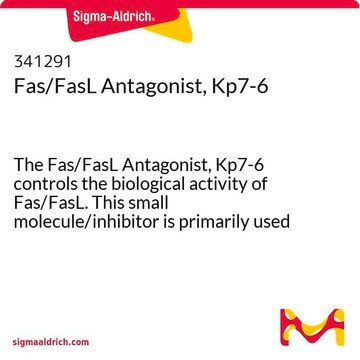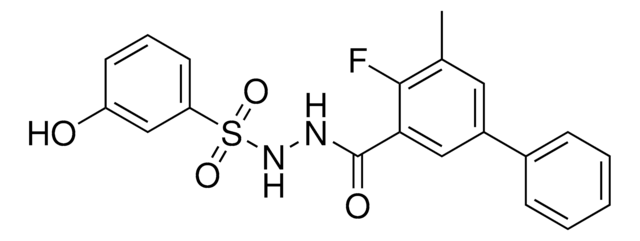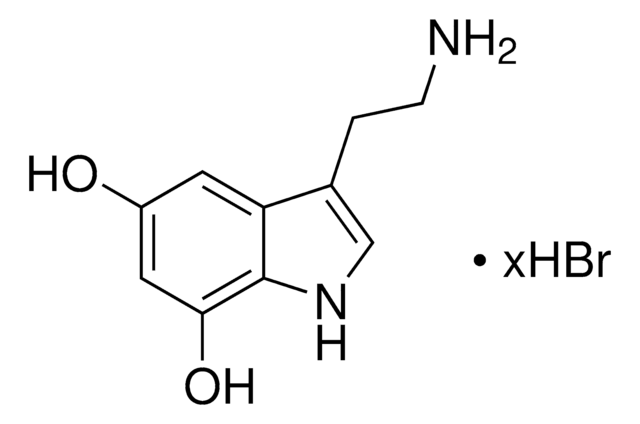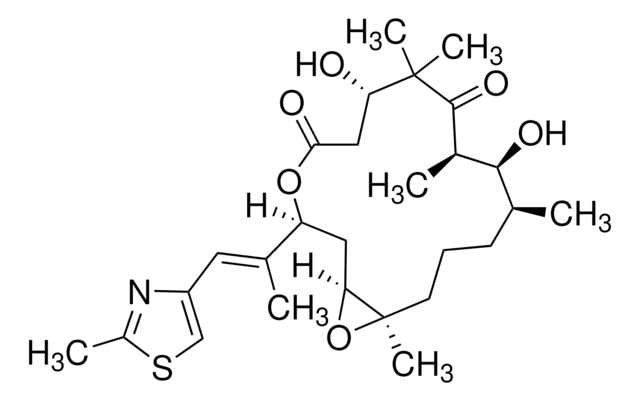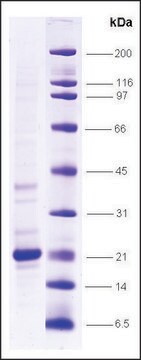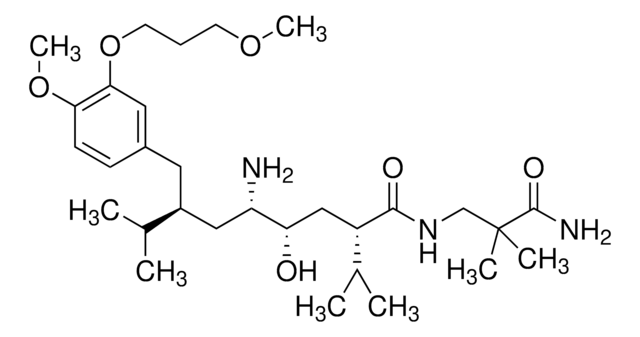SRP3036
Fas Ligand human
recombinant, expressed in CHO cells, ≥95% (SDS-PAGE), ≥95% (HPLC), suitable for cell culture
Sinonimo/i:
APTL, Apo I Ligand, CD95L, TNFSF6, soluble Fas Ligand (sFasL)
Autenticatiper visualizzare i prezzi riservati alla tua organizzazione & contrattuali
About This Item
Codice UNSPSC:
12352200
NACRES:
NA.32
Prodotti consigliati
Origine biologica
human
Ricombinante
expressed in CHO cells
Saggio
≥95% (HPLC)
≥95% (SDS-PAGE)
Stato
lyophilized
Potenza
≤10.0 ng/mL
PM
17.9 kDa
Confezionamento
pkg of 10 μg
tecniche
cell culture | mammalian: suitable
Impurezze
<0.1 EU/μg endotoxin, tested
Colore
white to off-white
Compatibilità
suitable for molecular biology
N° accesso UniProt
Condizioni di spedizione
wet ice
Temperatura di conservazione
−20°C
Informazioni sul gene
human ... FASLG(356)
Descrizione generale
Fas Ligand (FasL) is a member of the TNF (tumor necrosis factor) superfamily that is expressed on the cell surface of activated T cells. It can be present as soluble form in the circulation or membrane bound form in cells. Recombinant human soluble Fas Ligand is a 17.9kDa protein comprising the TNF homologous region of FasL and contains an 8 residue N-terminal His-Tag. Both human and murine sFasL are fully active on human and murine cells.
Applicazioni
Fas ligand human has been used to induce apoptosis in T-cell lymphoma-derived HuT78 cells and jurkat cells.
Azioni biochim/fisiol
Binding of Fas Ligand (FasL) to Fas receptor triggers apoptosis in Fas-bearing cells. FasL has the ability to kill T cells and activated B cells which leads to down-regulation of the immune response. The mechanism of Fas induced apoptosis involves recruitment of pro-caspase 8 through an adaptor molecule called FADD (Fas-Associated protein with death domain) followed by processing of the pro-enzyme to active forms. These active caspases then cleave various cellular substrates leading to the eventual cell death. FasL is also involved in AGE (advanced glycation end-product)-mediated apoptosis in human retinal ARPE-19 cells, suggesting its role in diabetic retinopathy. Changes in the activity of FasL suppresses normal apoptosis, leading to abnormal survival and growth of tumor cells. Mutations in the FasL gene causes autoimmune lymphoproliferative syndrome.
Sequenza
HHHHHHHHPS PPPEKKELRK VAHLTGKSNS RSMPLEWEDT YGIVLLSGVK YKKGGLVINE TGLYFVYSKV YFRGQSCNNL PLSHKVYMRN SKYPQDLVMM EGKMMSYCTT GQMWARSSYL GAVFNLTSAD HLYVNVSELS LVNFEESQTF FGLYKL
Stato fisico
Lyophilized with no additives.
Ricostituzione
Centrifuge the vial prior to opening. Reconstitute in water to a concentration of 0.1-1.0 mg/ml. Do not vortex. This solution can be stored at 2-8°C for up to 1 week. For extended storage, it is recommended to further dilute in a buffer containing a carrier protein (example 0.1% BSA) and store in working aliquots at -20°C to -80°C.
Codice della classe di stoccaggio
11 - Combustible Solids
Classe di pericolosità dell'acqua (WGK)
WGK 3
Punto d’infiammabilità (°F)
Not applicable
Punto d’infiammabilità (°C)
Not applicable
Scegli una delle versioni più recenti:
Possiedi già questo prodotto?
I documenti relativi ai prodotti acquistati recentemente sono disponibili nell’Archivio dei documenti.
Fas ligand mediates activation-induced cell death in human T lymphocytes.
Alderson MR, et al.
The Journal of Experimental Medicine, 71-77 (1995)
The molecular architecture of the TNF superfamily.
Bodmer JL, et al.
Trends in Biochemical Sciences, 27, 19-26 (2002)
The metalloproteinase matrilysin proteolytically generates active soluble Fas ligand and potentiates epithelial cell apoptosis.
Powell WC, et al.
Current Biology, 9, 1441-1447 (1999)
Karthik M Kodigepalli et al.
Cell cycle (Georgetown, Tex.), 16(2), 179-188 (2016-12-09)
Sterile α motif and HD domain-containing protein 1 (SAMHD1) is a mammalian dNTP hydrolase (dNTPase) that regulates intracellular dNTP balance. We have previously reported that SAMHD1 mRNA and protein levels are significantly downregulated in CD4
D H Lynch et al.
Immunity, 1(2), 131-136 (1994-05-01)
The gene for the mouse Fas ligand was cloned and its chromosomal position determined. Fasl was tightly linked to gld (no crossovers in 567 meiotic events) on mouse chromosome 1 and closely linked with a novel member of the same
Il team dei nostri ricercatori vanta grande esperienza in tutte le aree della ricerca quali Life Science, scienza dei materiali, sintesi chimica, cromatografia, discipline analitiche, ecc..
Contatta l'Assistenza Tecnica.